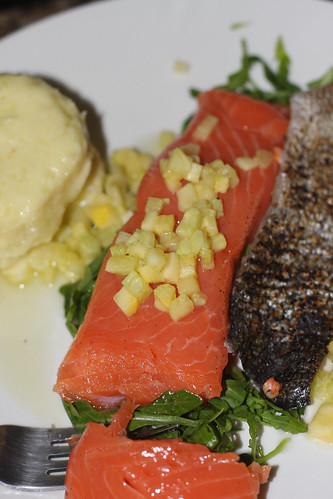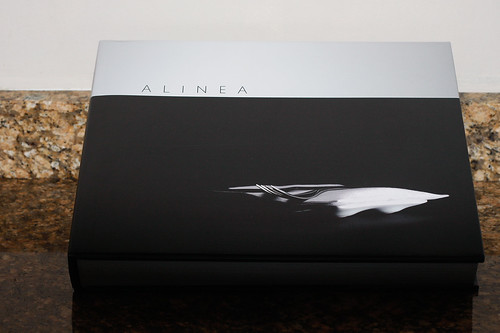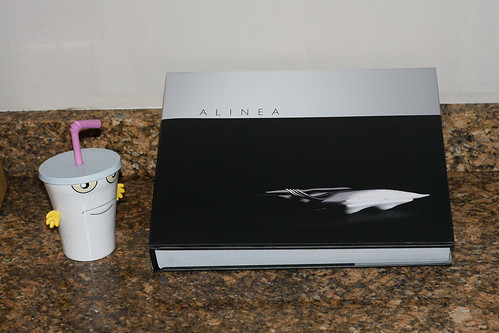Still waiting for the book of course so I have decided to keep myself busy with various other recipes. One thing I have been dying to try is salmon mi cuit (half/semi cooked). This is salmon which is cooked in 104F oil. Nathan M offers a recipe in the
WSL Article that I thought would do the trick.
So I decided to copy that but cook it sous vide by taking hints from Nathan and
Douglas.
I headed over to
Whole Foods for the salmon as well as the vanilla beans and herbs. I got two fillets of coho salmon from WF, not sure if they were wild or not but it was the most expensive at ~$16/lb so lets pretend it was. mmmm kay? In any case the fish looked delicious for a Sunday night with no smell and, I later found out, fresh taste. I
would did eat it raw and it tasted delicious.
A fun fact to mention is that salmon has all sorts of parasites and germs that you may want to kill via freezing for 24 hours. That being said I usually eat it raw and do not pay much attention to the food safety aspect. If you are making this for immune compromised people, you probably should. More information can be read on Douglas' site.
At the same time as copying it I wanted to add some flavor. Being the inventive sort that I am I Googled "
Salmon Mi Cuit" and came up on
this recipe.
In reading this article one of the things I remembered from Douglas was that salmon could develop some ugly looking albumen
leakage. Which is unpleasant to consider, let alone eat. So I made a brine of 10% salt by adding 100g of salt to 1L of tap water. I left the skin on one piece for comparison purposes. I also left some skin on the salmon for want of better knife skillz.

After a little bit of finesse I cleaned it up a bit into:

That's my super sweet Yanagi (japanese fish knife) underneath it. I carefully wash it and always dry it completely before putting it away, unfortunately you will notice the tip is slightly broken off and it has some staining (rust?) which is just one of the perils of roommate living. If anyone knows how to take better care of this I would appreciate the info.
At this point I realize I had to infuse the oil by cooking it on the stove for 30 minutes. So I put the salmon back in the fridge and mix up the infused oils.
Here is my mise en place (I don't know why that squash is in the picture either):
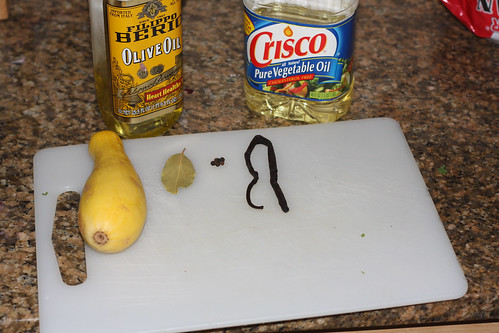
That vanilla bean looks delicious so here is a close up:
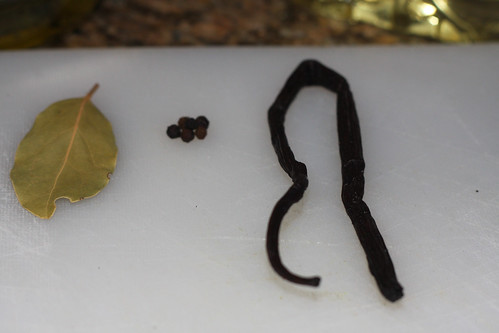
I actually only used half the bean and 1/3rd the other ingredients. I only needed 2 tbsp for these fillets and 1/3rd the recipe still yields 6.8 tbsp of infused oil. I was feeling awesome so I decided to make the infused oil by heating it in a water bath @ 55.5C for 35 Minutes. In order to do this I filled a ziplock with half a bean, split and scraped along with the other seasonings.
I zipped all but a little bit of the seal and submerged it in water to push most of the air out and then zipped it fully. I employed a complicated retaining mechanism, aka a wire basket with a plastic doohickey wedged in to counteract not all the air getting out and expanding to make it float:

I then blended the basil (fresh from my little herb garden), parsley and olive oil in this mini food processor gadget that came with my immersion blender:
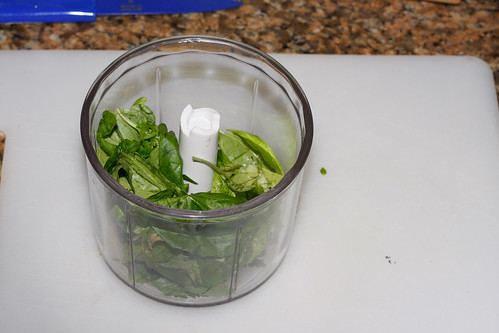
A little straining later and I end up with this semi-opaque oil:
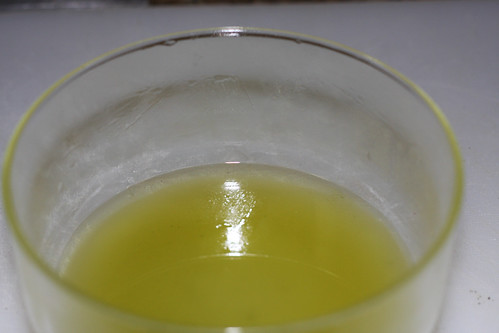
Now it was time to start cooking the taters, russets I believe:
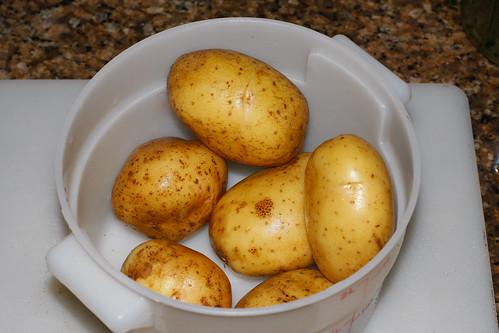
The recipe says to boil these whole for 15 minutes or as long as it takes for them to soften, and then peel them. Of course this did not work at all and after 15 minutes and I ended up quartering these to cook them faster.
When they were cooked I just pulled the skins off, I left them on to add that little bit of extra flavor, you can see below how easily the skins were to remove before mashing (or left on if you want):
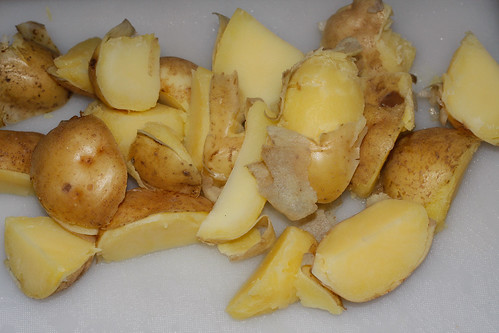
I was left with the skins, which I would normally put in a compost pile. However, I have never actually owned a compost pile so I was going to throw them away. Instead I fed them to my
dog roommates.
I added some butter and and 1/3rd of a cup of milk and mashed my little heart out until I was left with a smooth puree. I let this sit on low while I completed the recipe and added the basil oil before mixing one last time and serving it.
I then took my oil filled bags out of the freezer, I was concerned they wouldn't have frozen but was greeted by opaque oil so I was all set:
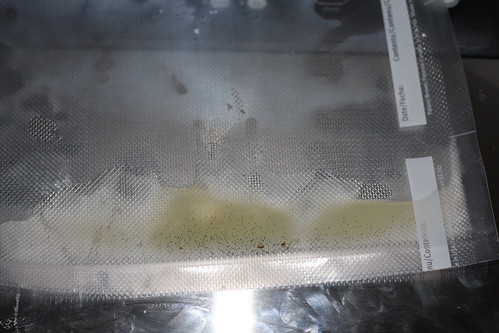
Ok, that shot looks pretty gross, but that's what you should look for, add the brined fillet and vacuum seal. I set mine to high vacuum and moist contents to get it out quickly before the oil melted and to get a good seal just in case some did get sucked out. I was left with this delicious looking salmon:
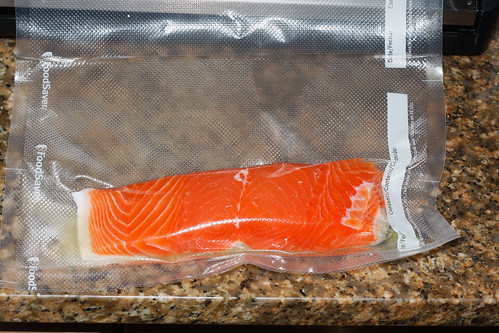
I cooked it for 14 minutes @ 40C as per the WSJ article.
I then cubed some yellow summer squash and sauteed it for a hot second in some olive oil.
While that was sauteing that I crisped the skin with my trusty little blowtorch. This will probably be replaced by a new torch soon but it did the job nicely here:

Now with 100% less flash:
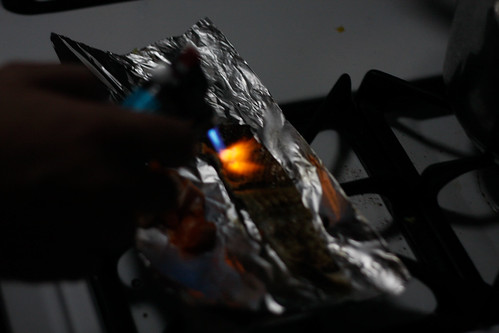
I plated the entire dish and drizzled some basil oil on the mashed potatoes and squash. It looked pretty delicious.
The texture was really out of this world and the taste was just right, I am glad I put in a little bit extra vanilla but it may have been helpful to crack or coarsely grind the pepper because not a lot of that flavor made it through to the salmon. This was almost the texture of gravlax or smoked salmon but more tender with an exquisite mouth feel, and yes it was that very vivid color, it seems that sous vide often has the nice effect of setting the color pleasantly.

And:
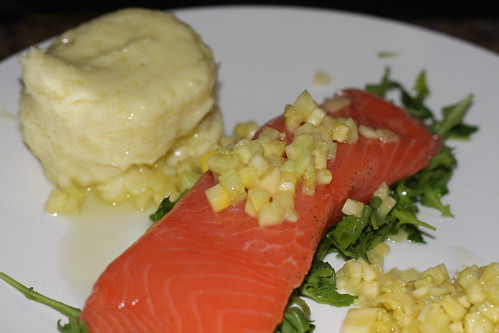
With the crisped skin, also delicious (but I am not really a big fan of fish skin in general):
